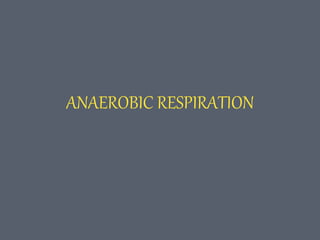
anaerobic respiration.ppt
- 2. Aerobic Respiration Overview • carbon flows to carbon dioxide • electrons flow to external acceptor • energy produced by oxidative phosphorylation through PMF
- 3. Respiration of Glucose glucose pyruvate Citric Acid Cycle Electron Transport System CO2 e- ½ O2 H20 glycolysis Electrons flow in the form of reduced dinucleotides (NADH and FADH) ADP ATP GDP GTP
- 4. 4 Oxidation Without O2 1. Anaerobic respiration – Use of inorganic molecules (other than O2) as final electron acceptor – Many prokaryotes use sulfur, nitrate, carbon dioxide or even inorganic metals 2. Fermentation – Use of organic molecules as final electron acceptor
- 5. Anaerobic Respiration • Some bacteria are capable of aerobic respiration and anaerobic respiration (aerobic is preferred due to more favorable energy production) • Other bacteria that carry out anaerobic respiration are obligate anaerobes • In either case, the electron acceptor chosen is based on maximizing free energy production for cell growth
- 6. Anaerobic (Anoxic) Respiration of Organics • Organic compounds are most often the original electron donor • Most electron acceptors are inorganic. • Electron transport systems in anaerobic respiration is similar to that of aerobic metabolism
- 7. Nitrate Reduction (Denitrification) • Conversion of nitrate (NO3 - ) as an electron acceptor to ammonia (NH4 +) or nitrate (NO2 - ) • Nitrite undergoes further reduction to produce nitric oxide (NO), nitrous oxide (N2O), and nitrogen gas (N2), all of which are lost to the atmosphere • Denitrification results in a loss of nitrogen from ecosystems and is only carried out biologically by bacteria • Nitrogen removal treatment processes incorporate denitrification
- 8. Aerobic Respiration and Denitrification • During aerobic respiration, three areas where H+ is pumped out to establish PMF
- 9. Denitrification • Only two areas in ETC that pump out H+ as compared to three for aerobic respiration • Less energy generated
- 10. Respiration and Anaerobic Respiration (E. coli) Figure 21.14a
- 11. Respiration and Anaerobic Respiration (P. stutzeri) Figure 21.14c Periplasmic proteins
- 12. Sulfate Reduction • sulfate (SO4)reduction to sulfide (S2-)requires eight electrons • the first intermediate in this process is the production of sulfite (SO3 2-) and requires two electrons • conversion of sulfite to sulfide requires an additional six electrons
- 14. Electron Transport and Energy Conservation during Sulfate Reduction Figure 21.16 Membrane-associated propotein complex